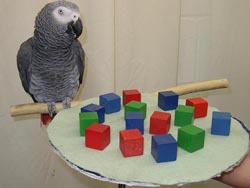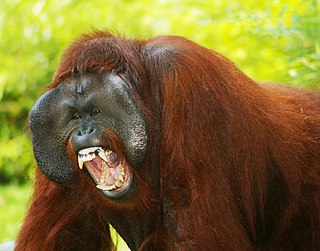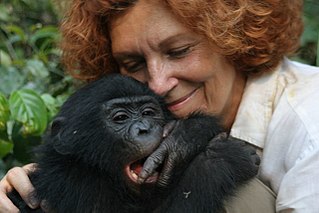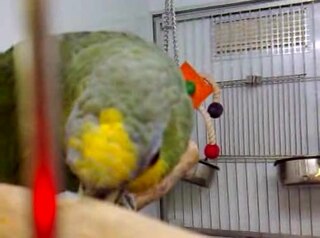Related Research Articles
Comparative psychology refers to the scientific study of the behavior and mental processes of non-human animals, especially as these relate to the phylogenetic history, adaptive significance, and development of behavior. The phrase comparative psychology may be employed in a narrow and a broad meaning. In its narrow meaning, it refers to the study of the similarities and differences in the psychology and behavior of different species. In a broader meaning, comparative psychology includes comparisons between different biological and socio-cultural groups, such as species, sexes, developmental stages, ages, and ethnicities. Research in this area addresses many different issues, uses many different methods and explores the behavior of many different species from insects to primates.

Animal cognition encompasses the mental capacities of non-human animals including insect cognition. The study of animal conditioning and learning used in this field was developed from comparative psychology. It has also been strongly influenced by research in ethology, behavioral ecology, and evolutionary psychology; the alternative name cognitive ethology is sometimes used. Many behaviors associated with the term animal intelligence are also subsumed within animal cognition.

Animal languages are forms of non-human animal communication that show similarities to human language. Animals communicate through a variety of signs, such as sounds and movements. Signing among animals may be considered a form of language if the inventory of signs is large enough. The signs are relatively arbitrary, and the animals seem to produce them with a degree of volition. In experimental tests, animal communication may also be evidenced through the use of lexigrams by chimpanzees and bonobos.

Alex was a grey parrot and the subject of a thirty-year experiment by animal psychologist Irene Pepperberg, initially at the University of Arizona and later at Harvard University and Brandeis University. When Alex was about one year old, Pepperberg bought him at a pet shop. In her book "Alex & Me", Pepperberg describes her unique relationship with Alex and how Alex helped her understand animal minds. Alex was an acronym for avian language experiment, or avian learning experiment. He was compared to Albert Einstein and at two years old was correctly answering questions made for six-year-olds.

Research into great ape language has involved teaching chimpanzees, bonobos, gorillas and orangutans to communicate with humans and each other using sign language, physical tokens, lexigrams, and imitative human speech. Some primatologists argue that the use of these communication methods indicate primate "language" ability, though this depends on one's definition of language. The cognitive tradeoff hypothesis suggests that human language skills evolved at the expense of the short-term and working memory capabilities observed in other hominids.
Dedre Dariel Gentner is an American cognitive and developmental psychologist. She is the Alice Gabriel Twight Professor of Psychology at Northwestern University, and a leading researcher in the study of analogical reasoning.

Human–animal communication is the communication observed between humans and other animals, ranging from non-verbal cues and vocalizations to the use of language.

The difficulty of defining or measuring intelligence in non-human animals makes the subject difficult to study scientifically in birds. In general, birds have relatively large brains compared to their head size. Furthermore, bird brains have two-to-four times the neuron packing density of mammal brains, for higher overall efficiency. The visual and auditory senses are well developed in most species, though the tactile and olfactory senses are well realized only in a few groups. Birds communicate using visual signals as well as through the use of calls and song. The testing of intelligence in birds is therefore usually based on studying responses to sensory stimuli.
N'kisi is a grey parrot thought to exhibit advanced English talking skills and other abilities.

Talking birds are birds that can mimic the speech of humans. There is debate within the scientific community over whether some talking parrots also have some cognitive understanding of the language. Birds have varying degrees of talking ability: some, like the corvids, are able to mimic only a few words and phrases, while some budgerigars have been observed to have a vocabulary of almost 2,000 words. The hill myna, a common pet, is well known for its talking ability and its relative, the European starling, is also adept at mimicry. Wild cockatoos in Australia have been reported to have learned human speech by cultural transmission from ex-captive birds that have integrated into the flock.

Animal consciousness, or animal awareness, is the quality or state of self-awareness within an animal, or of being aware of an external object or something within itself. In humans, consciousness has been defined as: sentience, awareness, subjectivity, qualia, the ability to experience or to feel, wakefulness, having a sense of selfhood, and the executive control system of the mind. Despite the difficulty in definition, many philosophers believe there is a broadly shared underlying intuition about what consciousness is.

Parrot training, also called parrot teaching, is the application of training techniques to modify the behavior of household companion parrots. Training is used to deal with behavior problems such as biting and screaming, to train husbandry behaviors such as allowing claw trimming without restraint or accepting a parrot harness, and to teach various tricks.
A talking animal or speaking animal is any non-human animal that can produce sounds or gestures resembling those of a human language. Several species or groups of animals have developed forms of communication which superficially resemble verbal language, however, these usually are not considered a language because they lack one or more of the defining characteristics, e.g. grammar, syntax, recursion, and displacement. Researchers have been successful in teaching some animals to make gestures similar to sign language, although whether this should be considered a language has been disputed.
Betsy is a black and white longhaired Border Collie, credited with being one of the world's most intelligent dogs.

The grey parrot, also known as the Congo grey parrot, Congo African grey parrot or African grey parrot, is an Old World parrot in the family Psittacidae. The Timneh parrot (Psittacus timneh) once was identified as a subspecies of the grey parrot, but has since been elevated to a full species.
Cosmo is a grey parrot who by the age of six had learned more than 200 words. She resides with Betty Jean Craige, University Professor Emerita of comparative literature and Director Emerita of the Willson Center for Humanities and Arts at the University of Georgia.
Intuitive statistics, or folk statistics, is the cognitive phenomenon where organisms use data to make generalizations and predictions about the world. This can be a small amount of sample data or training instances, which in turn contribute to inductive inferences about either population-level properties, future data, or both. Inferences can involve revising hypotheses, or beliefs, in light of probabilistic data that inform and motivate future predictions. The informal tendency for cognitive animals to intuitively generate statistical inferences, when formalized with certain axioms of probability theory, constitutes statistics as an academic discipline.

"The Great Silence" is a science fiction short story by American writer Ted Chiang that originated as the onscreen text for a video installation of the same name created in collaboration with Allora & Calzadilla. It was initially published as a story in e-flux Journal in May 2015. The story also appeared in the 2016 anthology The Best American Short Stories and in the 2019 collection Exhalation: Stories.
Alice Auersperg is an Austrian cognitive biologist specializing in the evolution of intelligence in birds. Her research is primarily focused on the physical cognition, play behavior, problem-solving and tool-making abilities in parrots and corvids. Since 2011, she has managed the Goffin Lab of Comparative Cognition at the Messerli Research Institute of the University of Veterinary Medicine Vienna in Austria, where she has extensively studied the intelligence of the Tanimbar corella, also known as the Goffin's cockatoo.

Apollo is an African grey parrot and the subject of the popular YouTube channel "Apollo and Frens" run by Victoria (Tori) Lacey and Dalton Mason. Apollo has been described as having the intelligence of a "human toddler" and can answer numerous complex questions in English.
References
- 1 2 3 4 5 "Dr. Irene Pepperberg". The Alex Foundation. Retrieved 19 January 2024.
- 1 2 3 4 5 6 "What's in a Bird's Brain?". The New Yorker . 2008-05-12. Retrieved 2019-12-11.
- 1 2 Pepperberg, Irene M. (2008). Alex & Me. HarperCollins.
- 1 2 3 4 5 "Profile: Irene Pepperberg & Alex Clip". Nova . Season 5, Episode 4. PBS. 9 February 2011 – via PBS.org.
- 1 2 "Alex the African Grey parrot". Brandeis.edu. Brandeis University. September 10, 2007. Retrieved December 12, 2019.
- 1 2 Royte, Elizabeth (November 7, 2008). "The Caged Bird Speaks". The New York Times. Retrieved December 11, 2019.
- 1 2 Pepperberg, I. (2002). Cognitive and Communicative Abilities of Grey Parrots. Current Directions in Psychological Science, 11(3), 83-87.
- ↑ Pepperberg, Irene. "Alex". The Alex Foundation. Retrieved January 12, 2021.
- ↑ Grandin, Temple (2005). Animals in Translation (First Harvest Edition 2006 ed.). New York: Simon & Schuster. p. 251. ISBN 978-0-15-603144-8.
- 1 2 Pepperberg, Irene M.; Sherman, Diane (October 2000). "Proposed Use of Two-Part Interactive Modeling as a Means to Increase Functional Skills in Children With a Variety of Disabilities". Teaching and Learning in Medicine. 12 (4): 213–220. doi:10.1207/S15328015TLM1204_10. PMID 11273372. S2CID 40103687.
- ↑ Fishman, Iris (December 2008). "What Alex the Parrot Can Teach Us About Working With Children With Complex Communication Needs". Perspectives on Augmentative and Alternative Communication. 17 (4): 144–149. doi:10.1044/aac17.4.144.
- ↑ "Alex the African Grey parrot and subject of landmark studies of bird intelligence dies at 31". alexfoundation.org. The Alex Foundation. Archived from the original on 2008-08-03.
- ↑ "African Grey Parrot is First Bird to Comprehend Numerical Concept Akin to Zero". Science Daily . July 11, 2005. Retrieved December 11, 2019.
- ↑ "Alex the African Grey". The Economist . September 20, 2007. Retrieved 2009-01-19.
Science's best known parrot died on September 6th, aged 31
- ↑ Trestman, Michael (15 January 2015). "Clever Hans, Alex the Parrot, and Kanzi: What can Exceptional Animal Learning Teach us About Human Cognitive Evolution?". Biological Theory. 10 (1): 86–99. doi:10.1007/s13752-014-0199-2. S2CID 86461282.
- ↑ ApolloandFrens (2021-10-14). "ApolloandFrens Channel Description". YouTube. Archived from the original on 22 June 2023. Retrieved 2023-08-20.
- ↑ The Alex Foundation Inc., Nonprofit Organization Lookup, Melissa DATA Corp. Retrieved September 1, 2009.
- ↑ "Friday Grey Matters: Irene Pepperberg Interview!" Archived 2008-09-22 at the Wayback Machine , by Shelley Batts, December 8, 2006, ScienceBlogs. Retrieved September 1, 2009.
- ↑ "Support Us". alexfoundation.org. The Alex Foundation. Retrieved December 11, 2019.
- ↑ "Pigeons Trained to Spot Cancer". iflscience.com. 2015. Retrieved December 11, 2019.
- ↑ Levenson, Richard M.; Krupinski, Elizabeth A.; Navarro, Victor M.; Wasserman, Edward A. (November 18, 2015). "Pigeons (Columba livia) as Trainable Observers of Pathology and Radiology Breast Cancer Images". PLOS ONE. 10 (11): e0141357. Bibcode:2015PLoSO..1041357L. doi: 10.1371/journal.pone.0141357 . PMC 4651348 . PMID 26581091.
- ↑ "Beyond Words". Central Square Theater. Retrieved 2024-03-31.